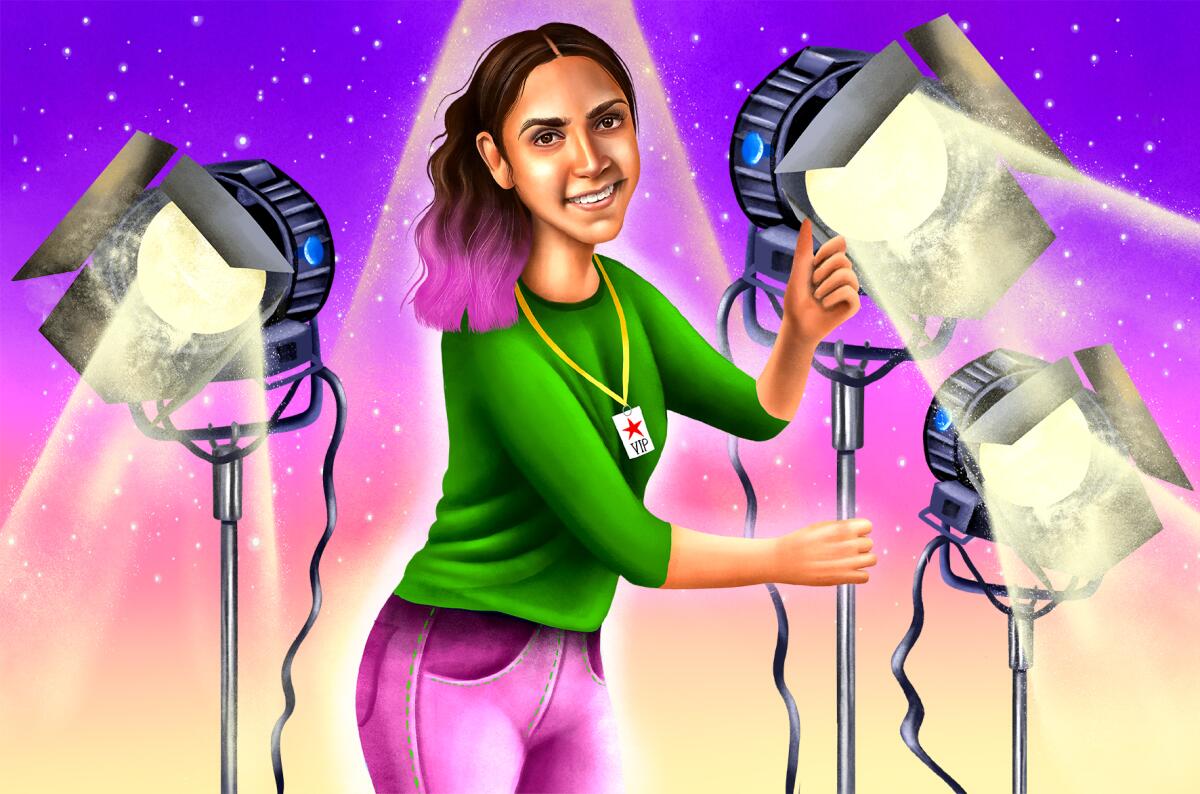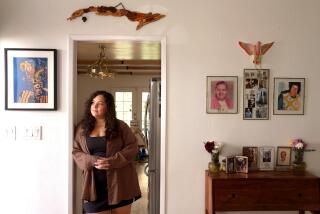Explaining Hollywood: How to get a job as a gaffer

- Share via
To set the mood of a scene in a movie, TV show or video, filmmakers give the audience plenty of nonverbal clues — in the locale, the props, the soundtrack, even the camera angles. But one important and often subtle signal is sent through the way the scene is lighted, which often involves lamps, shades and filters even when the sun is shining.
The way light falls on a character in a scene can set the emotional tone of the story, just as it can when a character is shrouded in darkness. The person who oversees the production’s lighting and electrical needs is the crew’s chief lighting technician, better known as the gaffer.
The job is part technical, part artistic, said gaffer David Goodman. He illustrated this point with an anecdote from the most recent project he worked on, “Hopeless,” a dark but humor-inflected short film due next year.
Although the story takes place in a home at night, filming was done during the day. It was easy enough for Goodman to hide the daylight by blacking out the windows. The challenge was removing the shadows his lights were creating inside the home.
But then Goodman realized the problematic shadows actually added to the mood of the film. “I thought it really went with the feeling of the script,” he said, “because the actors’ performances were really fun, dark and kind of psycho.”
Goodman talked with the cinematographer and suggested the team make the shadows part of the film’s characters. “So whenever we were composing our frames for our shots, if there was an opportunity to put an actor closer to a wall and create a shadow of their movement, we did it,” he said.
The Times talked to Goodman, fellow gaffer Tom Guiney and director of photography Veronica Bouza about what sort of qualities you find in a gaffer, how to start a career in this field, and what tips they can share from their experiences on set.
Who becomes a gaffer?
There aren’t any specific educational requirements for this job. However, a gaffer needs to know a lot about power, lighting equipment and a camera’s parameters (including such things as scene composition, film and shutter speeds, and lens aperture). You can learn these skills by studying film production as an undergrad.
For example, the Los Angeles Film School has a 36-month program that covers all aspects of the production process, including grip and electrical work. Graduates earn a bachelor of science degree in film production.
Guiney argues that you don’t have to become an electrician to be a gaffer; you just need to know the basics and you’ll learn the rest on the job. But if you want to get deep into the specifics of electrical training, there are vocational and certification programs you can enroll in. One example: at Fullerton College, you can earn a certificate as a lighting technician through a program that prepares graduates for jobs in the theatrical, theme park, TV and film worlds.
Beyond that, like many people on a film crew, a gaffer has to be a creative individual, a problem solver and a team player. The collaboration starts in pre-production; Goodman said a gaffer commonly works with the director of photography and in some cases the director too, going over filming locations, gear and lighting plans.
Veronica Bouza, director of photography, said she views the gaffer as her sounding board and right hand.
“As a director of photography, I expect the gaffer to inspire ideas, have thoughts and push me creatively,” she said.
Gaffers also need to be able to adapt quickly to changes on set, which requires both a command of the technical aspects of the job and a willingness to turn on a dime. Productions are typically under a tight schedule, Bouza said, so it’s great to have someone who is calm under stress and who understands how to use time efficiently.
Finally, a gaffer needs leadership skills. That’s because he or she will manage a team of crew members who set up power lines, lights and related equipment.
Ever wondered how they get a dog to smile on camera? That’s the job of the animal trainers working behind the scenes.
How do you get started?
As with many positions in Hollywood, Goodman said, you have to work your way up to becoming a gaffer. He would know; over the course of his 31-year career, he has worked in various lighting and electrical posts on sets.
Larger productions typically staff their lighting teams with electricians who set up the scenes for filming, electricians who work during filming, lighting technicians, an assistant chief lighting technician (also called a “best boy,” an antiquated term for a role that has no gender) and a gaffer, as well as people who specialize in light fixtures and the operation of the lighting control board. Then there are the grips who set up non-electrical equipment, including shades and filters to alter the lighting.
But it may be easier to gain a foothold in student films and lower-budget productions. That’s the path followed by Guiney, who worked more than 20 years as a gaffer in New York and Los Angeles on reality TV sets and music videos.
Guiney got his start in the lighting world working as a production assistant while studying cinematography in college. His curiosity and willingness to learn got him invited to work on low budget films, where he learned the bulk of the gaffer trade. He got his first insights into the role light plays in filmmaking, he said, by talking on set with camera and lighting crews.
Guiney and Goodman suggested two other ways to become a gaffer.
Speak up on set Once you’ve found a place as a production assistant, Guiney said, you should make it known that you’re interested in learning more about what gaffers do and how to become one.
He said he’s typically reluctant to accept a production assistant’s help, but he makes an exception for someone who is truly showing interest. You can do that by making yourself available to help in any way (even if that means wrapping up cords), knowing when to ask questions and being observant on set.
“We always need more people, so if you have a basic level of understanding and are a quick learner, you’ll be considered,” Guiney said. Once you’re granted permission to help, he said, you can work you way up the various grip and electric positions underneath the gaffer.
Work in an equipment rental warehouse It might not be an ideal steppingstone, Guiney said, but working in a rental warehouse where gaffers get their equipment is a great way to learn what everything is called. According to Guiney, there are “a million little pieces of equipment,” and you need to know how to wrap and store them properly.
Often, he said, crew members coming in to pick up equipment will say they need more people and ask if the owner has anyone to spare. Although you might not know a gaffer’s process, you’ll know what everything is and can be a valuable last-minute addition to the team.
Rejection and uncertainty are part of working in Hollywood, but joy, creativity and fun can be too. Here’s how to manage your mental health.
What are the career paths?
There are opportunities both inside and outside the entertainment industry. Bouza has parlayed her experience as a camera assistant and gaffer into credits as a director of photography and cinematographer. And Guiney has hung out his shingle as a gaffer for hire in the Bay Area, working mainly on corporate and marketing videos.
How do you make money? And how much?
When you’re a beginning gaffer, Guiney said, you’re not going to make much money and will most likely “need a lot of roommates.” Not only will the work be intermittent, but your daily pay rate is going to be lower than what an experienced gaffer can command.
Once you’ve worked enough to join the International Alliance of Theatrical Stage Employees union (Local 728 represents gaffers in the Los Angeles area), your rate will depend on which union contract, if any, is in force on your project. IATSE sets the pay scale for various positions in a crew’s electrical team, gaffer included.
There are different minimum rates for different types of projects, ranging from $27 per hour for a low-budget production to nearly $52 an hour for studio films and TV shows.
Not all productions employ union crews. When there’s no contract in play, the producers typically set the pay rate at less than union scale.
Both Goodman and Guiney, who worked on union and nonunion projects, said you might have to volunteer your time while holding another job at the beginning or offer a rate of $150 or less for a 10- to 12-hour workday.
Neither professional supports the idea of newcomers working below minimum wage, but they said it’s a common practice in the industry. Based on their experiences, they said it could take at least five years before you can sustain yourself. That’s entirely dependent on how many projects you can line up in a year.
Goodman remembers his father encouraging him years ago not to devalue himself. “He told me, ‘What the hell are you doing? Why are you working for all these jokers and working for no money? They’re just abusing you,’” he said.
Goodman’s father suggested he charge a minimum rate of $300 a day and never go below it, to weed out the people who where taking advantage of him. He told Goodman to embrace saying “no.”
It was difficult at first to decline offers below his rate, he said, but the payoff was worth it. Goodman said he never takes on a new project below his rate, even to this day.
The first step in your Hollywood career shouldn’t be paying L.A. rent. Here’s how to take your first steps toward a career in the entertainment industry, according to experts.
How is this career different than it was 10 or 25 years ago?
The major game changer in the gaffer world has been LED lights, Guiney said. The battery-powered bulbs have eliminated the need for portable generators and bulky electric cables. This new equipment has saved gaffers money and time with its versatility. But it also means that the number of people on a team has shrunk.
On a major studio project, he said, a gaffer can manage a team of 20 or more people. But on small projects, Guiney will handle the lighting and electrical work solo.
What’s some good advice?
Situational awareness Know when to jump into action and make suggestions and when to stay out of the way. Don’t ask questions when the camera is rolling, Guiney said. And when you notice the grip and electric team is taking down equipment, offer to help.
Along the same lines, Goodman said there will be some directors of photography who want collaboration and others who want to tell you exactly what you do. “You have to be able to understand the direction, and you have to be clear with your direction for your crew,” he said.
Enjoy the job Bouza said that having a gaffer on board who genuinely enjoys lighting scenes, actively contributing creative solutions or ideas to each image at any given moment, injects energy that’s infectious and brightens the overall mood of the team.
Invest in gear Guiney said investing in your gaffing career means buying your own equipment and keeping it organized. It helps over the long haul too because it saves you money on rental fees.
If you’re just starting out, Guiney said, you’ll need a kit of commonly used tools, including a circuit tester, voltage and current meters, various gauges of wire and Setwear-brand pro leather gloves for handling hot equipment. A complete kit of essential tools is not cheap, however; expect to spend $1,000 to $2,000, depending on whether you opt for new or used gear.
Send the L.A. Times your questions about breaking into and working in the entertainment industry.
More to Read
Inside the business of entertainment
The Wide Shot brings you news, analysis and insights on everything from streaming wars to production — and what it all means for the future.
You may occasionally receive promotional content from the Los Angeles Times.















